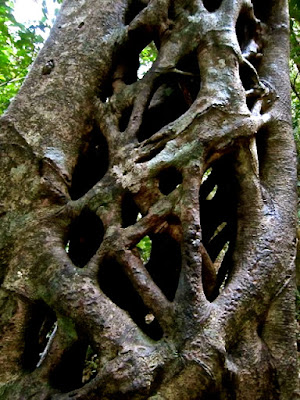Amazing!
Survival of the fittest may be the first law of the jungle, but strangler figs (Ficus aurea) are living proof that clever opportunists get along just fine, too. Several types of figs (Ficus spp.) are called "stranglers" because they grow on host trees, which they slowly choke to death. Ficus citrifolia, F. microcarpa, F. aurea and that happy little houseplant lurking in the living room, F. benjamina, are all strangler figs.
Generally, strangler figs grown from seedlings planted in the ground or in pots behave themselves. Stray seeds deposited by birds or winds in tree canopies are another story. Depending on the species, strangler figs grow best in U.S. Department of Agriculture plant hardiness zones 9 through 11.
Establishment in Host Trees
When the sticky seeds from a strangler fig cling to clefts and crotches high up in another tree's canopy, they develop as epiphytes, or plants that grow on another plant, but are not parasites. Epiphytic growth is common in tropical rainforests, where the shade is so complete that seedlings have little chance of survival on the ground. The tiny fig plant gets its nutrients at first from sunlight filtering through the canopy, rainfall and leaf litter on the host tree.
Strangler Tree Growth
Once established, the young strangler figs begin sending aerial roots down to the ground, where they quickly dive into the soil and anchor themselves. The roots may dangle from the host tree's canopy or creep down its trunk. Once in contact with the ground, the fig enters a growth spurt, plundering moisture and nutrients that the host tree needs. The strangler fig's roots encircle the host tree's roots, cutting off its supply of food and water, ultimately killing the host tree.
Meanwhile, back at the epiphyte, the strangler fig is busy producing new leaves and shoots that soon become large enough to overshadow the host tree's foliage, stealing sunlight and rainfall from the host canopy. By the time the host tree is dead, the strangler fig is large and strong enough to stand on its own, usually encircling the lifeless, often hollow body of the host tree.
:o)



They have those trees in Florida, too! Yikes!
ReplyDeleteHere is a different killer tree. Don't stand under it.
ReplyDeleteNot Yikes, this is YIKES
Manchineel: The most deadly tree in the world
Video 3:46 min
https://youtu.be/uct8H9kV47g
Text and photos here:
https://infogalactic.com/info/Manchineel
0MG!!!! YIKES is right!!!!!!
Delete